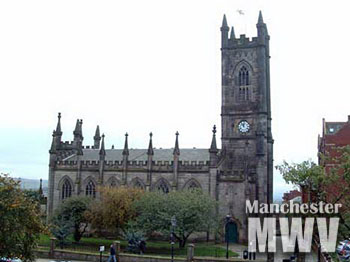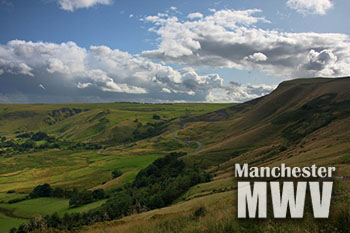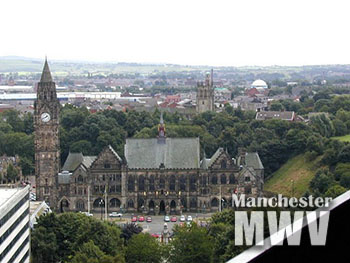Manchester is one of Britain’s most famous cities. An industrial centre, economic heart, educational and cultural hub – that’s all Manchester and more.
More and more tourists – both natives and international – come here every year in order to marvel at the many attractions and landmarks that the city has to offer. Let’s have a look at some of them. The following list includes both well known locations and places that usually stay under the radar of the regular tourist:
- Bolton Town Hall in Bolton to the south east of Hornwich is one of the most imposing buildings on the territory of Greater Manchester. The place has a Grade II listing. The original building was conceived in a neoclassical style that was imitating an ancient temple with rectangular form. A baroque-style clocktower was added to the layout as well. The latest addition was made after the great fire of 1981, when two public halls, the so called Albert Halls were added. Today Bolton Town Hall serves as a Civic Centre.
- If you are a fan of classical paintings, then you should definitely drop by the Bury Art Museum, which is easily accessible from Tottington Located on Moss Street, the gallery contains the collection of Victorian paper manufacturer Thomas Wrigley. Actually, the whole gallery and the foundation that is taking care of it was made possible by the generous donation of the works of art and funds in the will of Mr Wrigley, who passed away in 1880. The collection is home to works by some of the most famous artists of the day, including J. M. W. Turner, John Constable and Edwin Landseer.
 The Oldham Parish Church is recognized as being one of the finest and most masterfully executed churches from the beginning of the 19th century not only in Greater Manchester but in Britain as a whole. The parish church was completed in 1830 following the design and engineering solutions tailored by Richard Lane. The style that was followed during the construction of the building is Gothic Revival. Trust us, it can be breathtaking, especially the first time that you lay eyes on it. An interesting fact that a church has been in existence on the site ever since 1280s at least. It is also one of the few listed buildings in Oldham, together with a couple in Chadderton.
The Oldham Parish Church is recognized as being one of the finest and most masterfully executed churches from the beginning of the 19th century not only in Greater Manchester but in Britain as a whole. The parish church was completed in 1830 following the design and engineering solutions tailored by Richard Lane. The style that was followed during the construction of the building is Gothic Revival. Trust us, it can be breathtaking, especially the first time that you lay eyes on it. An interesting fact that a church has been in existence on the site ever since 1280s at least. It is also one of the few listed buildings in Oldham, together with a couple in Chadderton.- If you go to Rochdale the one place you should not miss to check out is the Rochdale Town Hall (yes, Greater Manchester has a number of rather spectacular town halls on its territory). This one has been designed in Gothic Revival style and was opened in 1871. Many art critics call it the best Gothic structure in Britain. It is famous for being admired by many famous persons, including Adolf Hitler, who was planning on moving it brick to brick to Nazi Germany upon the conquest of Britain during the Second World War. One of the best places to observe the way it dominates the town centre is from the top of Birch
 Tameside is a rather varied area. In addition to some industrial developments and more extensive suburban parts, the borough has many territories with semi-rural and rural character as well. So it is no surprise that there are many Nature Reserves in Tameside that you will definitely like if you are into walks in nature. The designated nature reserves in the borough are Knott Hill, Hollinwood Branch Canal, Great Wood, Haughton Dale, Hulmes and Hardy Woods, Castle Clough and Cowbury Dale, Hurst Clough and Rocher Vale, as well as Peak District National Park in Longendale.
Tameside is a rather varied area. In addition to some industrial developments and more extensive suburban parts, the borough has many territories with semi-rural and rural character as well. So it is no surprise that there are many Nature Reserves in Tameside that you will definitely like if you are into walks in nature. The designated nature reserves in the borough are Knott Hill, Hollinwood Branch Canal, Great Wood, Haughton Dale, Hulmes and Hardy Woods, Castle Clough and Cowbury Dale, Hurst Clough and Rocher Vale, as well as Peak District National Park in Longendale.- Trafford is primarily known as being home to Manchester United, which is not something to be taken lightly by no means. The area however contains a number of fine residential areas like Altrincham as well as other notable landmarks, including the magnificent Imperial North Museum North. It is a branch of the Imperial War Museum in London – one of the five that are in existence as of today. Imperial War Museum North has the noble and quite important mission to explore the impact that modern day conflicts have on the people and societies that are involved in them.
- The Manchester Apollo Theatre, today more frequently referred to as 02 Apollo Manchester is one of the best known concert venues in the city. Located in the district of Ardwick, the venue is an Art Deco building dating to the 1930s. It played a vital role in the thriving music scene of Manchester in the 1970s and 1980s, and to this day remains an important part of the city’s cultural landscape.
- Moss Side on the other hand is home to Manchester’s two best known, loved and maintained public parks – Alexandra Park and Whitworth Park. We take the liberty of mentioning them as local attractions for the simple reason that both open spaces are designed in the best traditions of the British gardening that they are pieces of art in their own right. Whitworth Park is furthermore the location of the Whitworth Art Gallery, and you will find the remnants of the old Aerodrome in Alexandra park that are now turned into football and rugby pitches.
 The All Saints Church in Newton Heath is an interesting historical landmark for a number of reasons. The history of the church can be traced to 1556, the same period when large groups of French Huguenots settled down in the area. It is the definitely the oldest structure still standing in these parts of Manchester, so it definitely deserves your attention. The building is literally a relic from a time that is both long gone and actually quite forgotten today.
The All Saints Church in Newton Heath is an interesting historical landmark for a number of reasons. The history of the church can be traced to 1556, the same period when large groups of French Huguenots settled down in the area. It is the definitely the oldest structure still standing in these parts of Manchester, so it definitely deserves your attention. The building is literally a relic from a time that is both long gone and actually quite forgotten today.- Another really interesting church that is to be found on the territory of Greater Manchester is the Church of St. Wilfrid in Northernden. The original structure of the church, which to this day remains in the core of the building, dates to the Late Middle Ages, e.g. the middle of the 15th century. The temple however went through a major renovation in the 19th century that was carried out by architect J.S. Crowther. A notable fact is that we can find a mention of a church on the same spot in the Domesday Book as well, which means that the origins of St Wilfrid may very well turn out to be Saxon.